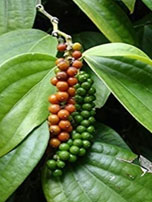SHAHEED KARTAR SINGH SARABHA AYURVEDIC MEDICAL COLLEGE & HOSPITAL
Affiliated to Guru Ravidas Ayurved University, Hoshiarpur Punjab
Affiliated to Guru Ravidas Ayurved University, Hoshiarpur Punjab

Botanical Name : Piper nigrum Linn.
Family : Piperaceae
Introduction :
Maricha used as appetizer, carminative and anti-microbial also used in kitchens. There have white Varity that describing in Samhitas it may be the seeds of M.pterygosperma.
Scientific classification: Peppers make up the family Piperaceae of the order Piperales. Its representative genus is Piper. Pepper elders constitute the genus Peperomia. The pepper plant is classified as Piper nigrum. Chili and sweet peppers are derived from plants of the genus Capsicum, of the family Solanaceae. The Polynesian beverage kava is produced from the plant classified as Piper methysticum. The lizard’s-tail family is Saururaceae. The yerba mansa is classified as Anemopsis californica. The other family in the order Piperales is Chloranthaceae
Names in different Indian languages :
Hindi : Kali Mirchi
Telugu : Miriyalu
Tamil : Milaku, marisam
English : Black pepper
Marathi : Mirin
Gujrati : Kalamari
Bengali : Golmarich
Kannada : Karemanesu, ollimonasu, miri
Malayalam : Kurumulaku
Sanskrit : Maricha
Unani : Filfil Siyaah, Safed
Synonyms :
Vellaja, Uushna, Suvrrita, Krishnaa.
Classification according to Charaka, Susrutha & Vagbhata :
Charaka
Dipaniya, sulaprasamana, Krimighna, sirovirecanopaga
Susrutha
Pippalyãdi, Tryusana
Vagbhata
Pippalyãdi (AS.); Vatsakãdi (A.H.)
Varieties & adulterants – (CV – controversy, AD – adulterants) :
1. Black – processed
2. White – un-processed
3. Ksupaja Marica – unknown
4. Sveta(white) seeds of M.pterygosperma. [CV]
Piper alba
Morphology :
A branching & climbing perennial shrub. Branches stout, trailing and rooting at the nodes.
Leaves— simple, entire, 12.5-17.5 cm x 5.0-12.5 cm. glaucous beneath base acute, cordate.
Flowers— minute, borne in spike, usually dioecious, but the female often bears anthers and the male a pistillode. Fruiting spikes variable in length and rachis glabrous.
Fruits – globes or avoid, one seeded, bright red when ripe.
Seeds— globose, testa thin, perisperm hard
Flowers in rainy season and fruits in autumn.
Habitat & Distribution :
Mainly south-western India. Cultivated in Assam, Karnataka, Maharashtra and Kerala.
Chemical Constituents :
Piperene, piperethint, piperolein A & B, feruperine, dihydroferuperine, citronellol, cryptone. dihydrocarveol, beta – pinene, piperonal. camphene, beta-caryophyllene. Beta -alanine, pipecolic acid, carotene, ascorbic acid, pipercide etc.
Properties :
Rasa Katu
Guna Laghu. Tikshna
Virya Usna
Vipäka Katu
Karma : Kapha-vatahara, Avrsya. Dipana,pachana,krimighna, kasaghna
Carminative, anti periodic, digestive, anthelmintic, stomachic, diuretic, Stimulant, anticholerin, sialagogue, bechic, antiasthmatic.
Indications :
Pinasa, Kãsa, Pravahiak, Hrdroga, Krimi, sväsa, süla.
Useful in arthritis, asthma, fever, cough, catarrh, haemorrhoids, dysentery, dyspepsia, flatulence, indigestion
Part Used :
Fruit .
Dosage :
Powder 0.5-1 g.
Important Yogas or Formations :
Maha Marcyãdi taila, Maricyãdi taila, Teka rãja Marica, Agnitundivati, Maricyãdi cürna
Important research work going on :
(1) anti bacterial property
(2) Anti aconitum activity
(3) anti viral activity
(4) antifungal property
(5) insecticidal activity
(6) antitumor action
Therapeutic Uses :
(1) Kãsa— Marica is given with sugar candy, ghee and honey(S.S.Ut. 52118).
(2) Pamã— Powder of Marica shall he given with fresh cow ghee (Vai. Ma.)
